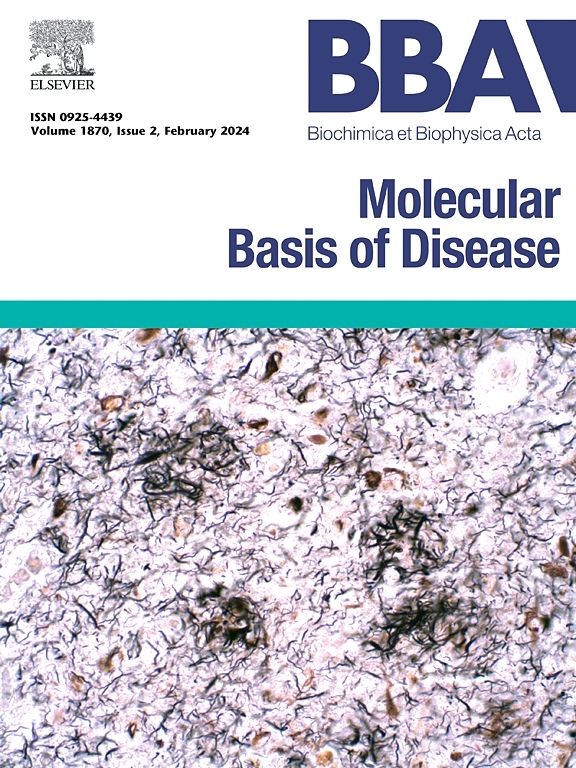SGLT2i通过靶向mTOR延缓c- myc诱导的HCC进展。
IF 4.2
2区 生物学
Q2 BIOCHEMISTRY & MOLECULAR BIOLOGY
Biochimica et biophysica acta. Molecular basis of disease
Pub Date : 2025-03-18
DOI:10.1016/j.bbadis.2025.167805
引用次数: 0
摘要
背景:肝细胞癌是一种以代谢重编程为特征的原发性肝脏恶性肿瘤。癌基因c-Myc通过驱动许多基因的转录发挥重要影响。恩格列清(EMPA)是一种钠-葡萄糖共转运蛋白-2抑制剂(SGLT2i),广泛应用于2型糖尿病的治疗,近年来因其潜在的抗癌作用而受到关注。本研究旨在揭示c-Myc、EMPA和哺乳动物雷帕霉素靶蛋白(mTOR)在HCC发生和进展中的复杂相互作用。方法:采用高压流体动力转染c-Myc质粒诱导小鼠肝癌。采用QPCR和免疫组化实验检测SGLT2在HCC组织中的表达。体内实验证实了c-Myc转染后SGLT2的上调。通过体内和体外研究来评价两种SGLT2i: EMPA和canagliflozin (CANA)的抗癌作用。网络药理学、分子对接分析、CETSA实验和附加的western blot实验揭示了EMPA与mTOR的相互作用抑制作用。结果:该研究发现HCC组织中SGLT2表达增加是c-Myc过表达的结果。体外实验证实了c-Myc转染后SGLT2的上调。值得注意的是,SGLT2i有效地抑制了小鼠肝癌的进展,并减少了肝脏脂肪的积累。在c- myc转染的细胞中,EMPA表现出明显的细胞增殖抑制作用。体外实验揭示了EMPA与mTOR的相互作用和抑制作用。结论:我们的研究强调了EMPA作为延缓HCC发生和进展的治疗药物的潜力。本文章由计算机程序翻译,如有差异,请以英文原文为准。

SGLT2i delays c-Myc-induced HCC progression via targeting mTOR
Background
Hepatocellular carcinoma (HCC) stands as a primary malignant liver tumor characterized by metabolic reprogramming. The oncogene c-Myc exerts substantial influence by driving the transcription of numerous genes. Empagliflozin (EMPA), a sodium-glucose cotransporter-2 inhibitor (SGLT2i), is widely used in the treatment of type 2 diabetes and has recently attracted attention for its potential anti-cancer effects. This study aims to unravel the complex interplay among c-Myc, EMPA, and the mammalian target of rapamycin (mTOR) in HCC development and progression.
Methods
HCC induction in mice utilized high-pressure hydrodynamic transfection of the c-Myc plasmid. QPCR and immunohistochemistry experiments were performed to detect the expression of SGLT2 in HCC tissues. In vivo experiments were conducted to corroborate the upregulation of SGLT2 following c-Myc transfection. In invo and vitro investigations were conducted to evaluate the anti-cancer effects of two SGLT2i: EMPA and canagliflozin (CANA). Network pharmacology, molecular docking analyses, CETSA experiments, and additional western blot experiments were used to reveal EMPA's interaction inhibition with mTOR.
Results
The study identified an increase in SGLT2 expression in HCC tissues as a result of c-Myc overexpression. In vitro experiments confirmed the upregulation of SGLT2 following c-Myc transfection. Notably, the administration of SGLT2i effectively curtailed liver cancer progression, and reduced hepatic fat accumulation in mice. EMPA exhibited significant suppression of cell proliferation in c-Myc-transfected cells. In vitro experiments unveiled EMPA's interaction and with inhibition the activation of mTOR.
Conclusion
Our study highlights EMPA's potential as a therapeutic agent in delaying the development and progression of HCC.
求助全文
通过发布文献求助,成功后即可免费获取论文全文。
去求助
来源期刊
CiteScore
12.30
自引率
0.00%
发文量
218
审稿时长
32 days
期刊介绍:
BBA Molecular Basis of Disease addresses the biochemistry and molecular genetics of disease processes and models of human disease. This journal covers aspects of aging, cancer, metabolic-, neurological-, and immunological-based disease. Manuscripts focused on using animal models to elucidate biochemical and mechanistic insight in each of these conditions, are particularly encouraged. Manuscripts should emphasize the underlying mechanisms of disease pathways and provide novel contributions to the understanding and/or treatment of these disorders. Highly descriptive and method development submissions may be declined without full review. The submission of uninvited reviews to BBA - Molecular Basis of Disease is strongly discouraged, and any such uninvited review should be accompanied by a coverletter outlining the compelling reasons why the review should be considered.

 求助内容:
求助内容: 应助结果提醒方式:
应助结果提醒方式:


